Strategic Management Approaches: A Comprehensive Report
VerifiedAdded on 2021/05/31
|15
|3462
|37
Report
AI Summary
This report provides an overview of strategic management, focusing on three key approaches: stakeholder, dynamic capabilities, and sustainable. It explores the viability, benefits, implementation issues, and limitations of each approach. The stakeholder approach emphasizes satisfying stakeholder needs for long-term success, while dynamic capabilities focus on adapting to rapid environmental changes. The sustainable approach centers on renewing the industry and contributing to a sustainable future. The report examines how these approaches can be implemented and the challenges associated with each, offering a comprehensive understanding of strategic management principles and their practical applications in various business contexts. The report discusses the benefits and limitations of each approach, providing a balanced perspective on their effectiveness.

Running head: STRATEGIC MANAGEMENT
Strategic Management
Name of the Student:
Name of the University:
Author Note:
Strategic Management
Name of the Student:
Name of the University:
Author Note:
Paraphrase This Document
Need a fresh take? Get an instant paraphrase of this document with our AI Paraphraser

1STRATEGIC MANAGEMENT
Executive Summary:
The report gives an overview of strategic management in the context of the three approaches.
Through the report one can get an idea about the concept of strategic management. There is also
discussion of the stakeholder approach, dynamic capabilities and the sustainable approach. The
report put forward a vivid description of each of the three approaches in terms of their viability,
benefits, implementation issues and their limitation.
Executive Summary:
The report gives an overview of strategic management in the context of the three approaches.
Through the report one can get an idea about the concept of strategic management. There is also
discussion of the stakeholder approach, dynamic capabilities and the sustainable approach. The
report put forward a vivid description of each of the three approaches in terms of their viability,
benefits, implementation issues and their limitation.
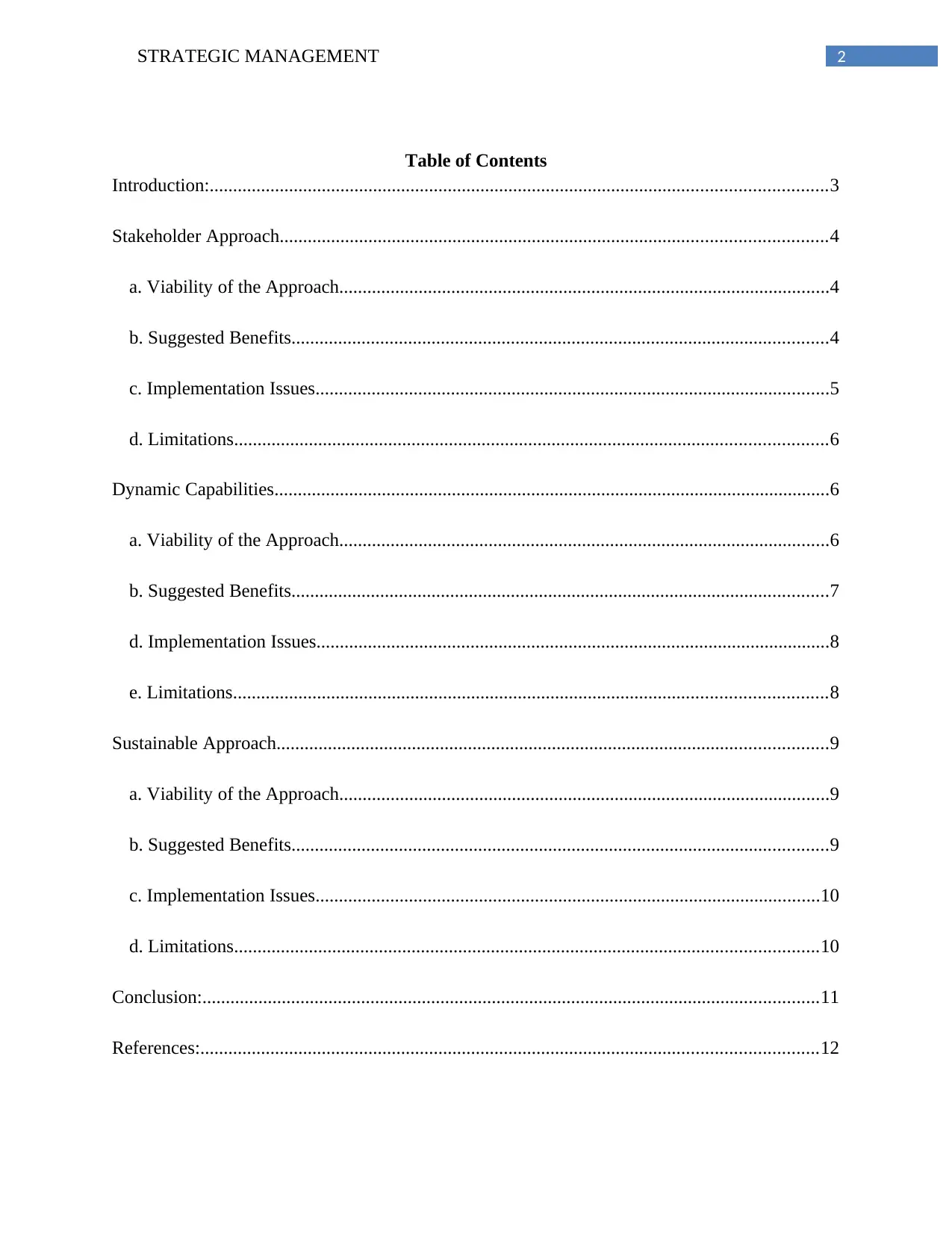
2STRATEGIC MANAGEMENT
Table of Contents
Introduction:....................................................................................................................................3
Stakeholder Approach.....................................................................................................................4
a. Viability of the Approach.........................................................................................................4
b. Suggested Benefits...................................................................................................................4
c. Implementation Issues..............................................................................................................5
d. Limitations...............................................................................................................................6
Dynamic Capabilities.......................................................................................................................6
a. Viability of the Approach.........................................................................................................6
b. Suggested Benefits...................................................................................................................7
d. Implementation Issues..............................................................................................................8
e. Limitations...............................................................................................................................8
Sustainable Approach......................................................................................................................9
a. Viability of the Approach.........................................................................................................9
b. Suggested Benefits...................................................................................................................9
c. Implementation Issues............................................................................................................10
d. Limitations.............................................................................................................................10
Conclusion:....................................................................................................................................11
References:....................................................................................................................................12
Table of Contents
Introduction:....................................................................................................................................3
Stakeholder Approach.....................................................................................................................4
a. Viability of the Approach.........................................................................................................4
b. Suggested Benefits...................................................................................................................4
c. Implementation Issues..............................................................................................................5
d. Limitations...............................................................................................................................6
Dynamic Capabilities.......................................................................................................................6
a. Viability of the Approach.........................................................................................................6
b. Suggested Benefits...................................................................................................................7
d. Implementation Issues..............................................................................................................8
e. Limitations...............................................................................................................................8
Sustainable Approach......................................................................................................................9
a. Viability of the Approach.........................................................................................................9
b. Suggested Benefits...................................................................................................................9
c. Implementation Issues............................................................................................................10
d. Limitations.............................................................................................................................10
Conclusion:....................................................................................................................................11
References:....................................................................................................................................12
⊘ This is a preview!⊘
Do you want full access?
Subscribe today to unlock all pages.

Trusted by 1+ million students worldwide
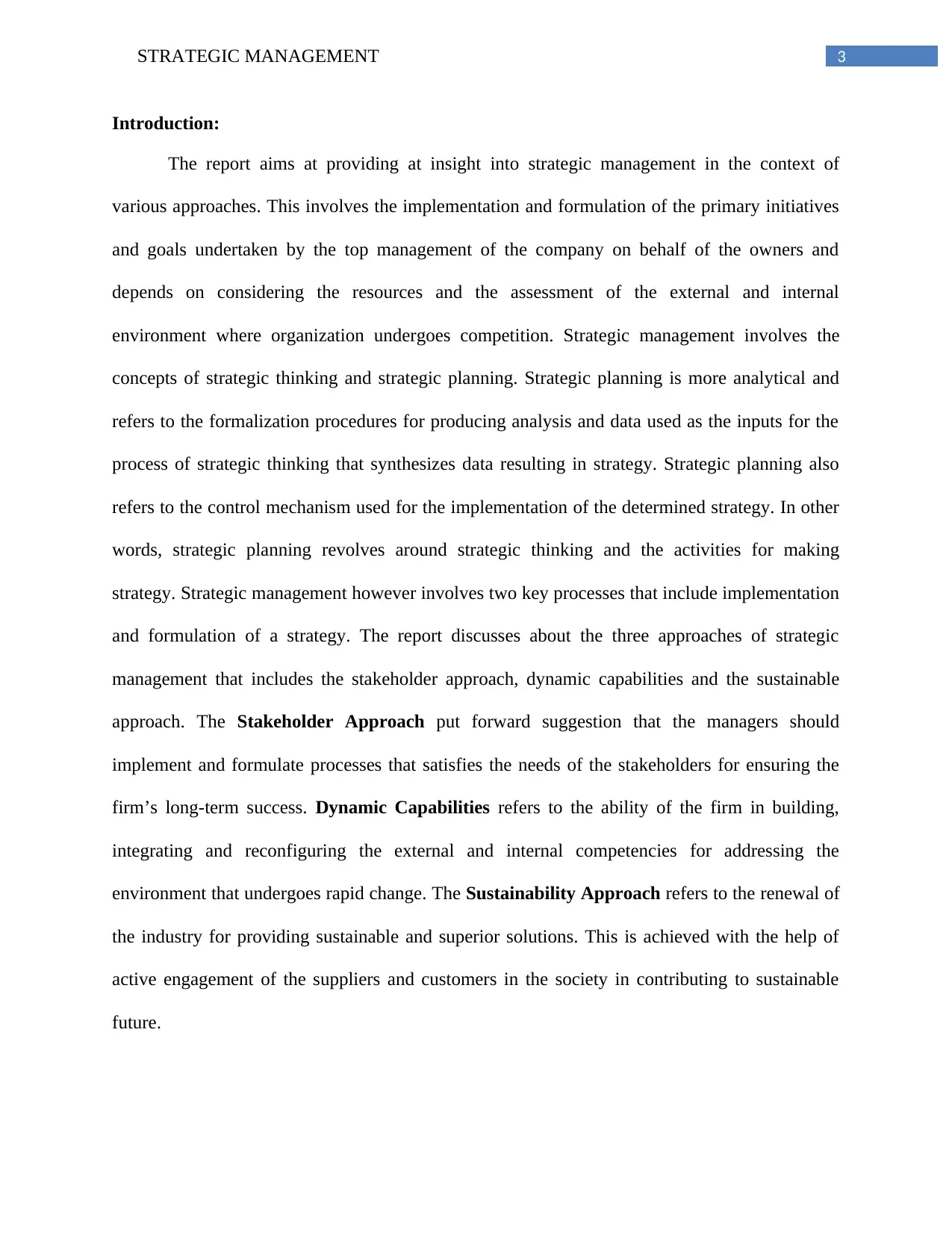
3STRATEGIC MANAGEMENT
Introduction:
The report aims at providing at insight into strategic management in the context of
various approaches. This involves the implementation and formulation of the primary initiatives
and goals undertaken by the top management of the company on behalf of the owners and
depends on considering the resources and the assessment of the external and internal
environment where organization undergoes competition. Strategic management involves the
concepts of strategic thinking and strategic planning. Strategic planning is more analytical and
refers to the formalization procedures for producing analysis and data used as the inputs for the
process of strategic thinking that synthesizes data resulting in strategy. Strategic planning also
refers to the control mechanism used for the implementation of the determined strategy. In other
words, strategic planning revolves around strategic thinking and the activities for making
strategy. Strategic management however involves two key processes that include implementation
and formulation of a strategy. The report discusses about the three approaches of strategic
management that includes the stakeholder approach, dynamic capabilities and the sustainable
approach. The Stakeholder Approach put forward suggestion that the managers should
implement and formulate processes that satisfies the needs of the stakeholders for ensuring the
firm’s long-term success. Dynamic Capabilities refers to the ability of the firm in building,
integrating and reconfiguring the external and internal competencies for addressing the
environment that undergoes rapid change. The Sustainability Approach refers to the renewal of
the industry for providing sustainable and superior solutions. This is achieved with the help of
active engagement of the suppliers and customers in the society in contributing to sustainable
future.
Introduction:
The report aims at providing at insight into strategic management in the context of
various approaches. This involves the implementation and formulation of the primary initiatives
and goals undertaken by the top management of the company on behalf of the owners and
depends on considering the resources and the assessment of the external and internal
environment where organization undergoes competition. Strategic management involves the
concepts of strategic thinking and strategic planning. Strategic planning is more analytical and
refers to the formalization procedures for producing analysis and data used as the inputs for the
process of strategic thinking that synthesizes data resulting in strategy. Strategic planning also
refers to the control mechanism used for the implementation of the determined strategy. In other
words, strategic planning revolves around strategic thinking and the activities for making
strategy. Strategic management however involves two key processes that include implementation
and formulation of a strategy. The report discusses about the three approaches of strategic
management that includes the stakeholder approach, dynamic capabilities and the sustainable
approach. The Stakeholder Approach put forward suggestion that the managers should
implement and formulate processes that satisfies the needs of the stakeholders for ensuring the
firm’s long-term success. Dynamic Capabilities refers to the ability of the firm in building,
integrating and reconfiguring the external and internal competencies for addressing the
environment that undergoes rapid change. The Sustainability Approach refers to the renewal of
the industry for providing sustainable and superior solutions. This is achieved with the help of
active engagement of the suppliers and customers in the society in contributing to sustainable
future.
Paraphrase This Document
Need a fresh take? Get an instant paraphrase of this document with our AI Paraphraser
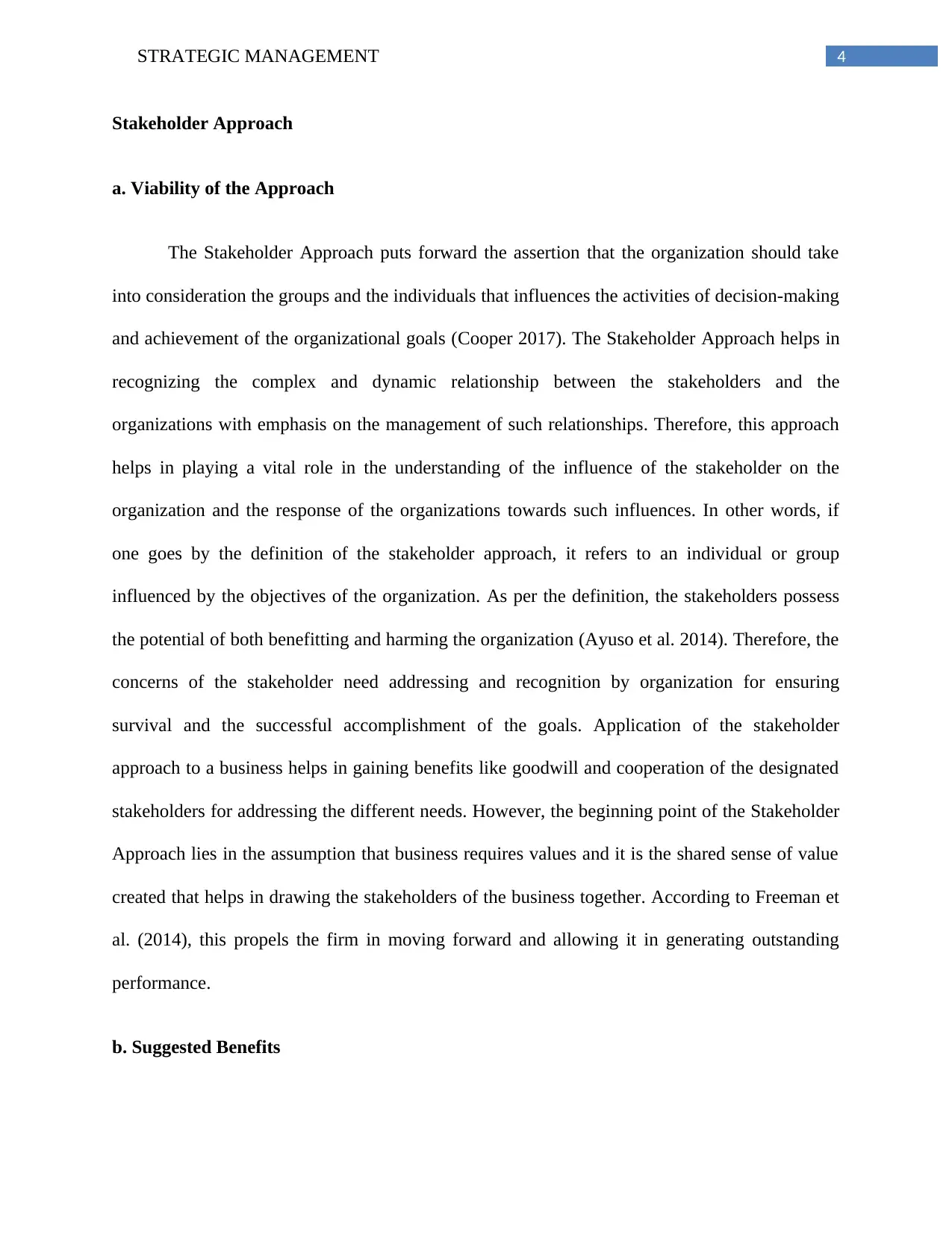
4STRATEGIC MANAGEMENT
Stakeholder Approach
a. Viability of the Approach
The Stakeholder Approach puts forward the assertion that the organization should take
into consideration the groups and the individuals that influences the activities of decision-making
and achievement of the organizational goals (Cooper 2017). The Stakeholder Approach helps in
recognizing the complex and dynamic relationship between the stakeholders and the
organizations with emphasis on the management of such relationships. Therefore, this approach
helps in playing a vital role in the understanding of the influence of the stakeholder on the
organization and the response of the organizations towards such influences. In other words, if
one goes by the definition of the stakeholder approach, it refers to an individual or group
influenced by the objectives of the organization. As per the definition, the stakeholders possess
the potential of both benefitting and harming the organization (Ayuso et al. 2014). Therefore, the
concerns of the stakeholder need addressing and recognition by organization for ensuring
survival and the successful accomplishment of the goals. Application of the stakeholder
approach to a business helps in gaining benefits like goodwill and cooperation of the designated
stakeholders for addressing the different needs. However, the beginning point of the Stakeholder
Approach lies in the assumption that business requires values and it is the shared sense of value
created that helps in drawing the stakeholders of the business together. According to Freeman et
al. (2014), this propels the firm in moving forward and allowing it in generating outstanding
performance.
b. Suggested Benefits
Stakeholder Approach
a. Viability of the Approach
The Stakeholder Approach puts forward the assertion that the organization should take
into consideration the groups and the individuals that influences the activities of decision-making
and achievement of the organizational goals (Cooper 2017). The Stakeholder Approach helps in
recognizing the complex and dynamic relationship between the stakeholders and the
organizations with emphasis on the management of such relationships. Therefore, this approach
helps in playing a vital role in the understanding of the influence of the stakeholder on the
organization and the response of the organizations towards such influences. In other words, if
one goes by the definition of the stakeholder approach, it refers to an individual or group
influenced by the objectives of the organization. As per the definition, the stakeholders possess
the potential of both benefitting and harming the organization (Ayuso et al. 2014). Therefore, the
concerns of the stakeholder need addressing and recognition by organization for ensuring
survival and the successful accomplishment of the goals. Application of the stakeholder
approach to a business helps in gaining benefits like goodwill and cooperation of the designated
stakeholders for addressing the different needs. However, the beginning point of the Stakeholder
Approach lies in the assumption that business requires values and it is the shared sense of value
created that helps in drawing the stakeholders of the business together. According to Freeman et
al. (2014), this propels the firm in moving forward and allowing it in generating outstanding
performance.
b. Suggested Benefits
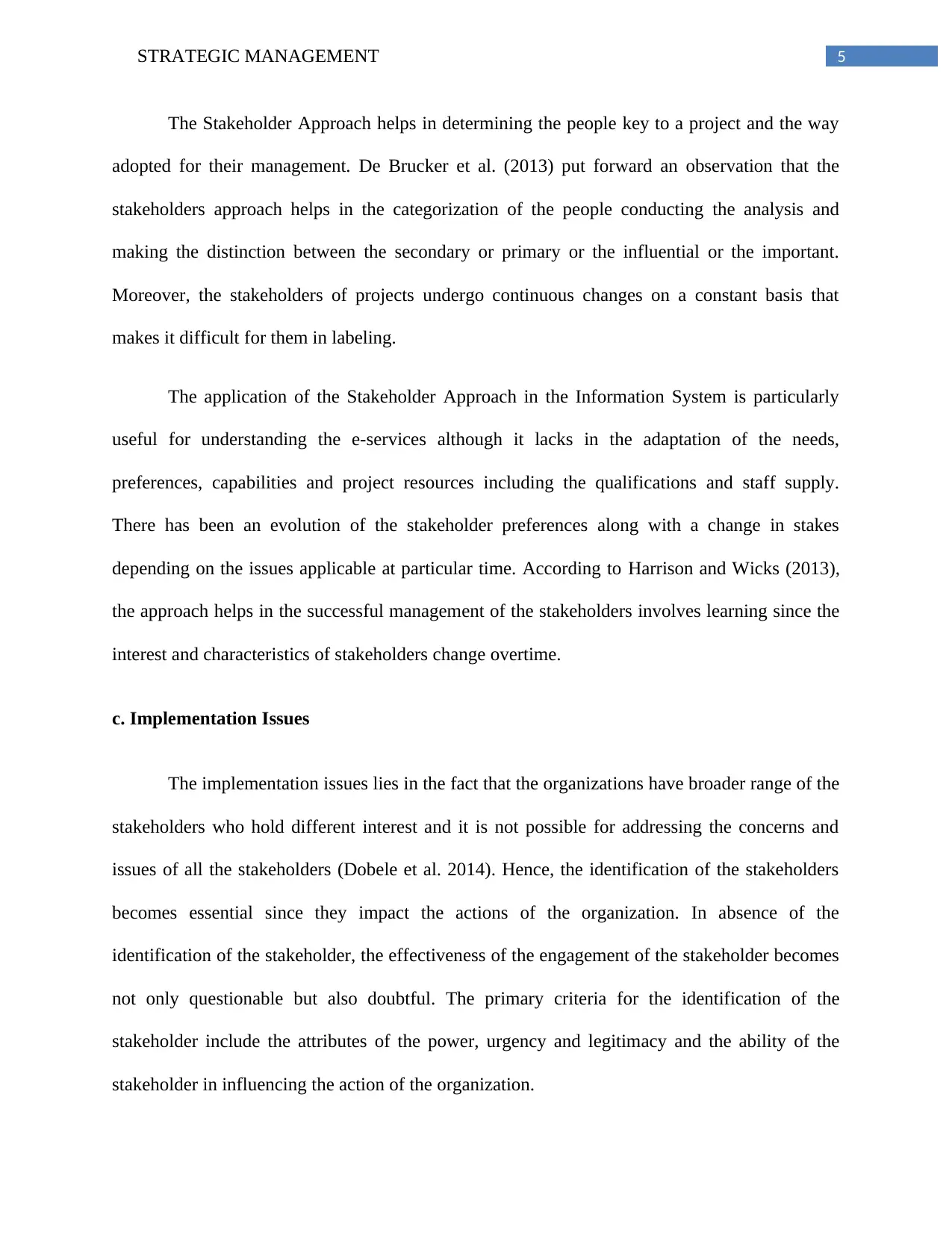
5STRATEGIC MANAGEMENT
The Stakeholder Approach helps in determining the people key to a project and the way
adopted for their management. De Brucker et al. (2013) put forward an observation that the
stakeholders approach helps in the categorization of the people conducting the analysis and
making the distinction between the secondary or primary or the influential or the important.
Moreover, the stakeholders of projects undergo continuous changes on a constant basis that
makes it difficult for them in labeling.
The application of the Stakeholder Approach in the Information System is particularly
useful for understanding the e-services although it lacks in the adaptation of the needs,
preferences, capabilities and project resources including the qualifications and staff supply.
There has been an evolution of the stakeholder preferences along with a change in stakes
depending on the issues applicable at particular time. According to Harrison and Wicks (2013),
the approach helps in the successful management of the stakeholders involves learning since the
interest and characteristics of stakeholders change overtime.
c. Implementation Issues
The implementation issues lies in the fact that the organizations have broader range of the
stakeholders who hold different interest and it is not possible for addressing the concerns and
issues of all the stakeholders (Dobele et al. 2014). Hence, the identification of the stakeholders
becomes essential since they impact the actions of the organization. In absence of the
identification of the stakeholder, the effectiveness of the engagement of the stakeholder becomes
not only questionable but also doubtful. The primary criteria for the identification of the
stakeholder include the attributes of the power, urgency and legitimacy and the ability of the
stakeholder in influencing the action of the organization.
The Stakeholder Approach helps in determining the people key to a project and the way
adopted for their management. De Brucker et al. (2013) put forward an observation that the
stakeholders approach helps in the categorization of the people conducting the analysis and
making the distinction between the secondary or primary or the influential or the important.
Moreover, the stakeholders of projects undergo continuous changes on a constant basis that
makes it difficult for them in labeling.
The application of the Stakeholder Approach in the Information System is particularly
useful for understanding the e-services although it lacks in the adaptation of the needs,
preferences, capabilities and project resources including the qualifications and staff supply.
There has been an evolution of the stakeholder preferences along with a change in stakes
depending on the issues applicable at particular time. According to Harrison and Wicks (2013),
the approach helps in the successful management of the stakeholders involves learning since the
interest and characteristics of stakeholders change overtime.
c. Implementation Issues
The implementation issues lies in the fact that the organizations have broader range of the
stakeholders who hold different interest and it is not possible for addressing the concerns and
issues of all the stakeholders (Dobele et al. 2014). Hence, the identification of the stakeholders
becomes essential since they impact the actions of the organization. In absence of the
identification of the stakeholder, the effectiveness of the engagement of the stakeholder becomes
not only questionable but also doubtful. The primary criteria for the identification of the
stakeholder include the attributes of the power, urgency and legitimacy and the ability of the
stakeholder in influencing the action of the organization.
⊘ This is a preview!⊘
Do you want full access?
Subscribe today to unlock all pages.

Trusted by 1+ million students worldwide
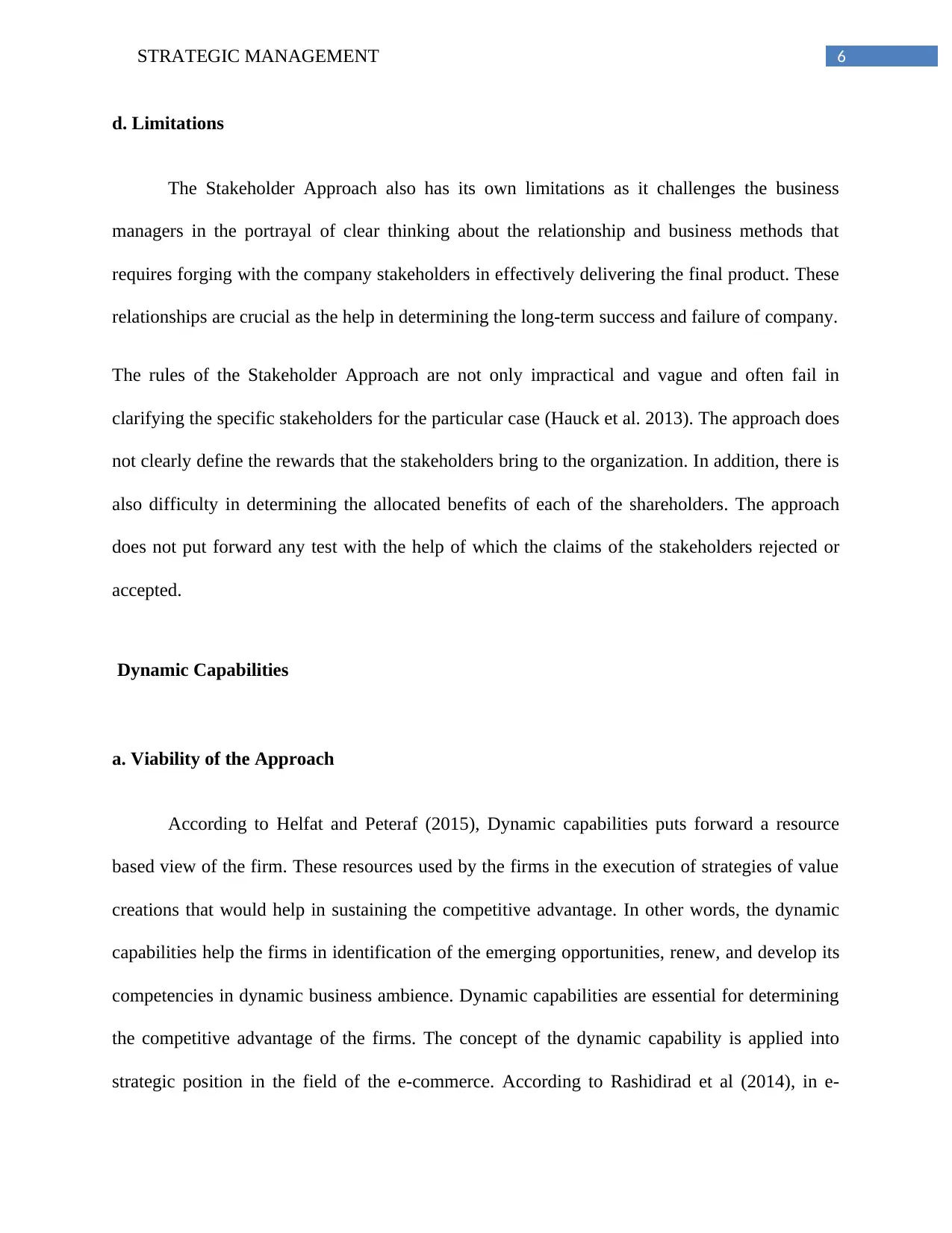
6STRATEGIC MANAGEMENT
d. Limitations
The Stakeholder Approach also has its own limitations as it challenges the business
managers in the portrayal of clear thinking about the relationship and business methods that
requires forging with the company stakeholders in effectively delivering the final product. These
relationships are crucial as the help in determining the long-term success and failure of company.
The rules of the Stakeholder Approach are not only impractical and vague and often fail in
clarifying the specific stakeholders for the particular case (Hauck et al. 2013). The approach does
not clearly define the rewards that the stakeholders bring to the organization. In addition, there is
also difficulty in determining the allocated benefits of each of the shareholders. The approach
does not put forward any test with the help of which the claims of the stakeholders rejected or
accepted.
Dynamic Capabilities
a. Viability of the Approach
According to Helfat and Peteraf (2015), Dynamic capabilities puts forward a resource
based view of the firm. These resources used by the firms in the execution of strategies of value
creations that would help in sustaining the competitive advantage. In other words, the dynamic
capabilities help the firms in identification of the emerging opportunities, renew, and develop its
competencies in dynamic business ambience. Dynamic capabilities are essential for determining
the competitive advantage of the firms. The concept of the dynamic capability is applied into
strategic position in the field of the e-commerce. According to Rashidirad et al (2014), in e-
d. Limitations
The Stakeholder Approach also has its own limitations as it challenges the business
managers in the portrayal of clear thinking about the relationship and business methods that
requires forging with the company stakeholders in effectively delivering the final product. These
relationships are crucial as the help in determining the long-term success and failure of company.
The rules of the Stakeholder Approach are not only impractical and vague and often fail in
clarifying the specific stakeholders for the particular case (Hauck et al. 2013). The approach does
not clearly define the rewards that the stakeholders bring to the organization. In addition, there is
also difficulty in determining the allocated benefits of each of the shareholders. The approach
does not put forward any test with the help of which the claims of the stakeholders rejected or
accepted.
Dynamic Capabilities
a. Viability of the Approach
According to Helfat and Peteraf (2015), Dynamic capabilities puts forward a resource
based view of the firm. These resources used by the firms in the execution of strategies of value
creations that would help in sustaining the competitive advantage. In other words, the dynamic
capabilities help the firms in identification of the emerging opportunities, renew, and develop its
competencies in dynamic business ambience. Dynamic capabilities are essential for determining
the competitive advantage of the firms. The concept of the dynamic capability is applied into
strategic position in the field of the e-commerce. According to Rashidirad et al (2014), in e-
Paraphrase This Document
Need a fresh take? Get an instant paraphrase of this document with our AI Paraphraser
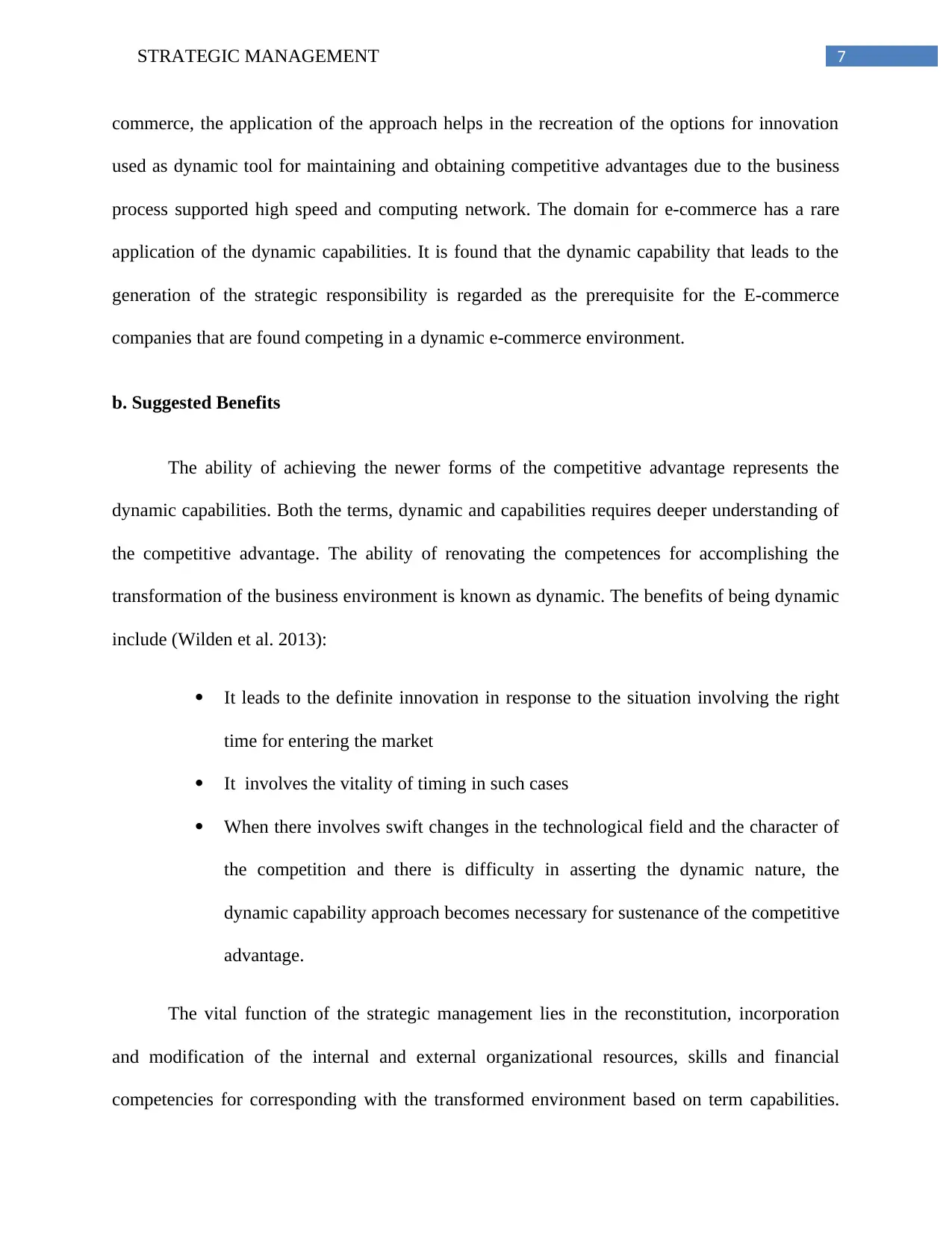
7STRATEGIC MANAGEMENT
commerce, the application of the approach helps in the recreation of the options for innovation
used as dynamic tool for maintaining and obtaining competitive advantages due to the business
process supported high speed and computing network. The domain for e-commerce has a rare
application of the dynamic capabilities. It is found that the dynamic capability that leads to the
generation of the strategic responsibility is regarded as the prerequisite for the E-commerce
companies that are found competing in a dynamic e-commerce environment.
b. Suggested Benefits
The ability of achieving the newer forms of the competitive advantage represents the
dynamic capabilities. Both the terms, dynamic and capabilities requires deeper understanding of
the competitive advantage. The ability of renovating the competences for accomplishing the
transformation of the business environment is known as dynamic. The benefits of being dynamic
include (Wilden et al. 2013):
It leads to the definite innovation in response to the situation involving the right
time for entering the market
It involves the vitality of timing in such cases
When there involves swift changes in the technological field and the character of
the competition and there is difficulty in asserting the dynamic nature, the
dynamic capability approach becomes necessary for sustenance of the competitive
advantage.
The vital function of the strategic management lies in the reconstitution, incorporation
and modification of the internal and external organizational resources, skills and financial
competencies for corresponding with the transformed environment based on term capabilities.
commerce, the application of the approach helps in the recreation of the options for innovation
used as dynamic tool for maintaining and obtaining competitive advantages due to the business
process supported high speed and computing network. The domain for e-commerce has a rare
application of the dynamic capabilities. It is found that the dynamic capability that leads to the
generation of the strategic responsibility is regarded as the prerequisite for the E-commerce
companies that are found competing in a dynamic e-commerce environment.
b. Suggested Benefits
The ability of achieving the newer forms of the competitive advantage represents the
dynamic capabilities. Both the terms, dynamic and capabilities requires deeper understanding of
the competitive advantage. The ability of renovating the competences for accomplishing the
transformation of the business environment is known as dynamic. The benefits of being dynamic
include (Wilden et al. 2013):
It leads to the definite innovation in response to the situation involving the right
time for entering the market
It involves the vitality of timing in such cases
When there involves swift changes in the technological field and the character of
the competition and there is difficulty in asserting the dynamic nature, the
dynamic capability approach becomes necessary for sustenance of the competitive
advantage.
The vital function of the strategic management lies in the reconstitution, incorporation
and modification of the internal and external organizational resources, skills and financial
competencies for corresponding with the transformed environment based on term capabilities.
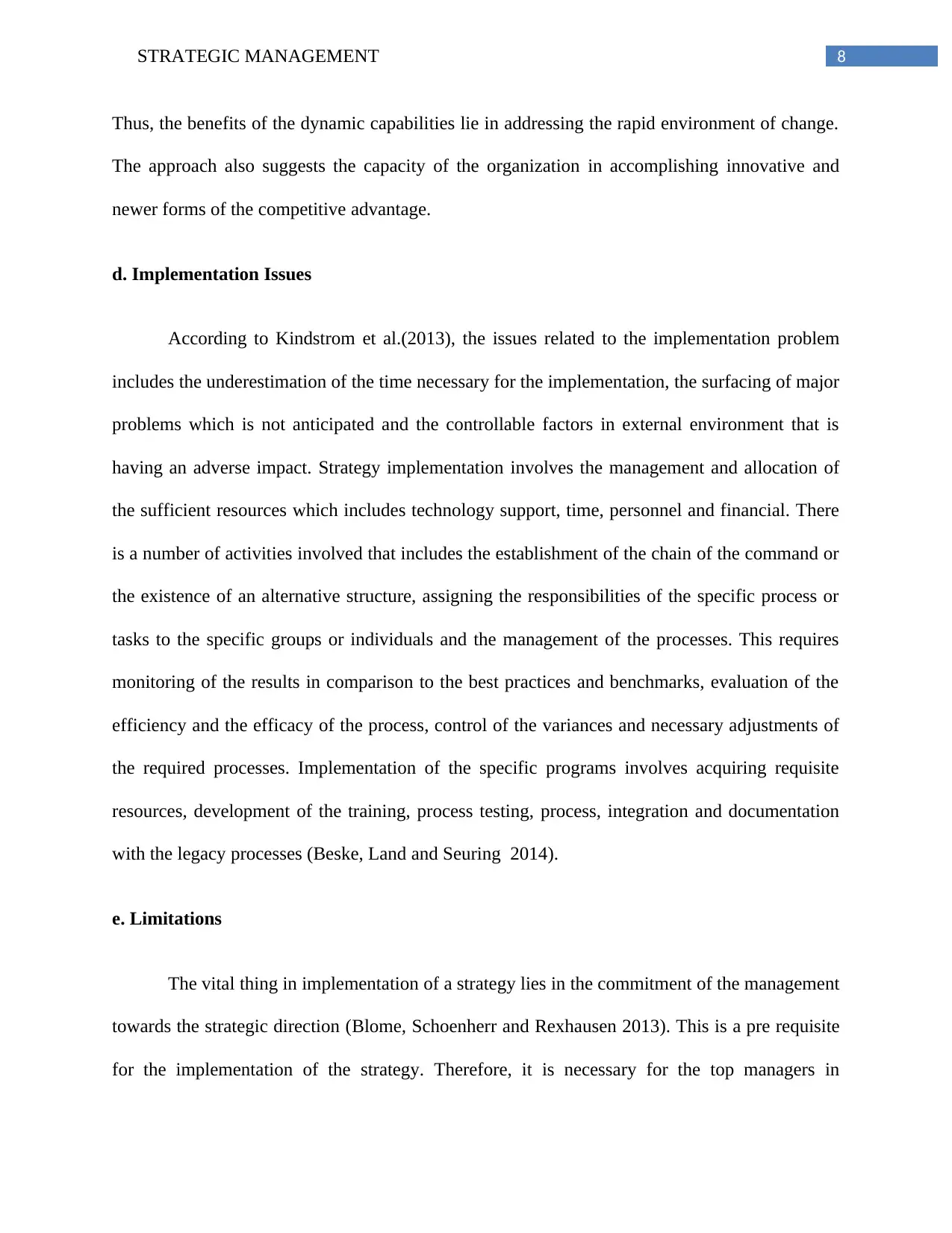
8STRATEGIC MANAGEMENT
Thus, the benefits of the dynamic capabilities lie in addressing the rapid environment of change.
The approach also suggests the capacity of the organization in accomplishing innovative and
newer forms of the competitive advantage.
d. Implementation Issues
According to Kindstrom et al.(2013), the issues related to the implementation problem
includes the underestimation of the time necessary for the implementation, the surfacing of major
problems which is not anticipated and the controllable factors in external environment that is
having an adverse impact. Strategy implementation involves the management and allocation of
the sufficient resources which includes technology support, time, personnel and financial. There
is a number of activities involved that includes the establishment of the chain of the command or
the existence of an alternative structure, assigning the responsibilities of the specific process or
tasks to the specific groups or individuals and the management of the processes. This requires
monitoring of the results in comparison to the best practices and benchmarks, evaluation of the
efficiency and the efficacy of the process, control of the variances and necessary adjustments of
the required processes. Implementation of the specific programs involves acquiring requisite
resources, development of the training, process testing, process, integration and documentation
with the legacy processes (Beske, Land and Seuring 2014).
e. Limitations
The vital thing in implementation of a strategy lies in the commitment of the management
towards the strategic direction (Blome, Schoenherr and Rexhausen 2013). This is a pre requisite
for the implementation of the strategy. Therefore, it is necessary for the top managers in
Thus, the benefits of the dynamic capabilities lie in addressing the rapid environment of change.
The approach also suggests the capacity of the organization in accomplishing innovative and
newer forms of the competitive advantage.
d. Implementation Issues
According to Kindstrom et al.(2013), the issues related to the implementation problem
includes the underestimation of the time necessary for the implementation, the surfacing of major
problems which is not anticipated and the controllable factors in external environment that is
having an adverse impact. Strategy implementation involves the management and allocation of
the sufficient resources which includes technology support, time, personnel and financial. There
is a number of activities involved that includes the establishment of the chain of the command or
the existence of an alternative structure, assigning the responsibilities of the specific process or
tasks to the specific groups or individuals and the management of the processes. This requires
monitoring of the results in comparison to the best practices and benchmarks, evaluation of the
efficiency and the efficacy of the process, control of the variances and necessary adjustments of
the required processes. Implementation of the specific programs involves acquiring requisite
resources, development of the training, process testing, process, integration and documentation
with the legacy processes (Beske, Land and Seuring 2014).
e. Limitations
The vital thing in implementation of a strategy lies in the commitment of the management
towards the strategic direction (Blome, Schoenherr and Rexhausen 2013). This is a pre requisite
for the implementation of the strategy. Therefore, it is necessary for the top managers in
⊘ This is a preview!⊘
Do you want full access?
Subscribe today to unlock all pages.

Trusted by 1+ million students worldwide
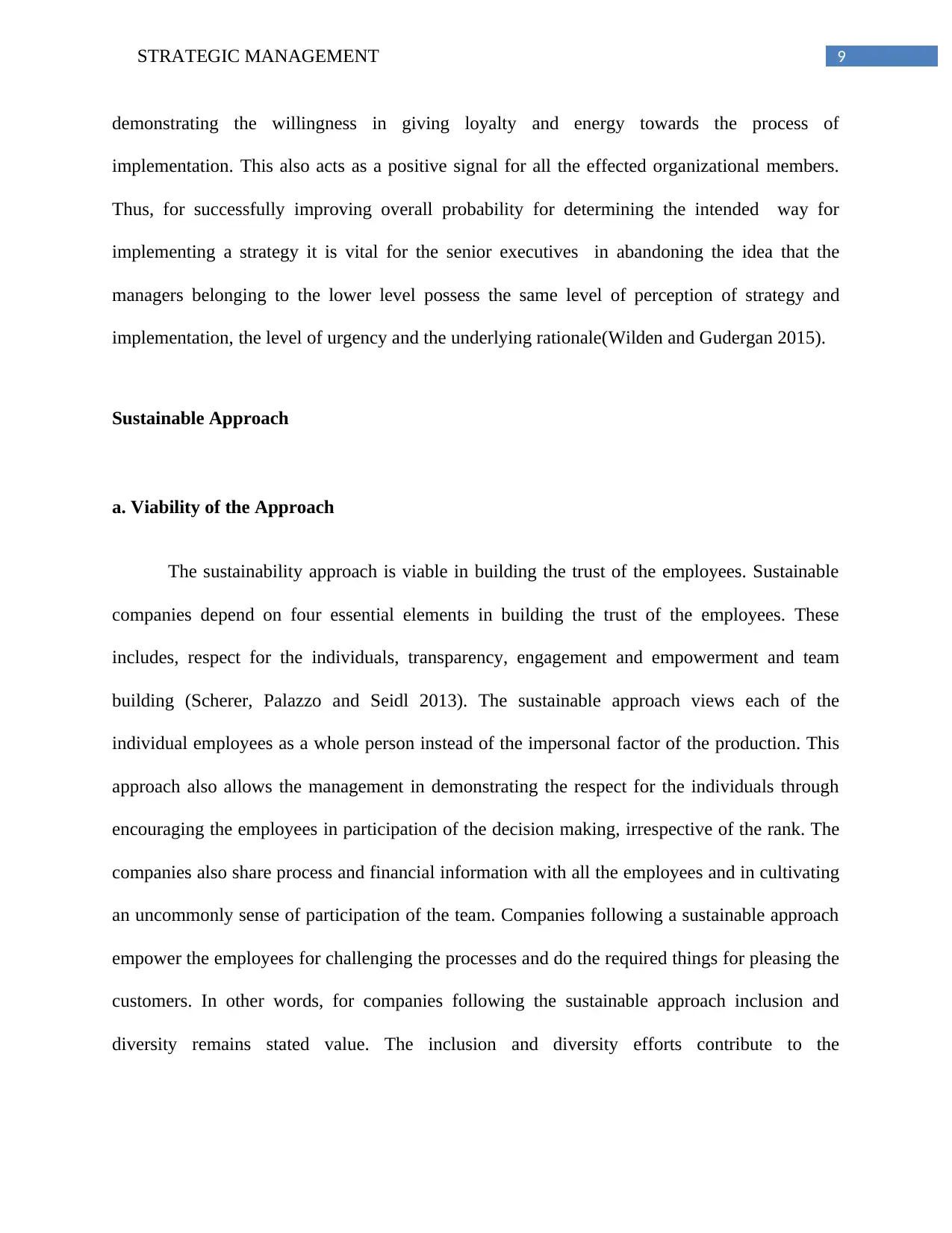
9STRATEGIC MANAGEMENT
demonstrating the willingness in giving loyalty and energy towards the process of
implementation. This also acts as a positive signal for all the effected organizational members.
Thus, for successfully improving overall probability for determining the intended way for
implementing a strategy it is vital for the senior executives in abandoning the idea that the
managers belonging to the lower level possess the same level of perception of strategy and
implementation, the level of urgency and the underlying rationale(Wilden and Gudergan 2015).
Sustainable Approach
a. Viability of the Approach
The sustainability approach is viable in building the trust of the employees. Sustainable
companies depend on four essential elements in building the trust of the employees. These
includes, respect for the individuals, transparency, engagement and empowerment and team
building (Scherer, Palazzo and Seidl 2013). The sustainable approach views each of the
individual employees as a whole person instead of the impersonal factor of the production. This
approach also allows the management in demonstrating the respect for the individuals through
encouraging the employees in participation of the decision making, irrespective of the rank. The
companies also share process and financial information with all the employees and in cultivating
an uncommonly sense of participation of the team. Companies following a sustainable approach
empower the employees for challenging the processes and do the required things for pleasing the
customers. In other words, for companies following the sustainable approach inclusion and
diversity remains stated value. The inclusion and diversity efforts contribute to the
demonstrating the willingness in giving loyalty and energy towards the process of
implementation. This also acts as a positive signal for all the effected organizational members.
Thus, for successfully improving overall probability for determining the intended way for
implementing a strategy it is vital for the senior executives in abandoning the idea that the
managers belonging to the lower level possess the same level of perception of strategy and
implementation, the level of urgency and the underlying rationale(Wilden and Gudergan 2015).
Sustainable Approach
a. Viability of the Approach
The sustainability approach is viable in building the trust of the employees. Sustainable
companies depend on four essential elements in building the trust of the employees. These
includes, respect for the individuals, transparency, engagement and empowerment and team
building (Scherer, Palazzo and Seidl 2013). The sustainable approach views each of the
individual employees as a whole person instead of the impersonal factor of the production. This
approach also allows the management in demonstrating the respect for the individuals through
encouraging the employees in participation of the decision making, irrespective of the rank. The
companies also share process and financial information with all the employees and in cultivating
an uncommonly sense of participation of the team. Companies following a sustainable approach
empower the employees for challenging the processes and do the required things for pleasing the
customers. In other words, for companies following the sustainable approach inclusion and
diversity remains stated value. The inclusion and diversity efforts contribute to the
Paraphrase This Document
Need a fresh take? Get an instant paraphrase of this document with our AI Paraphraser
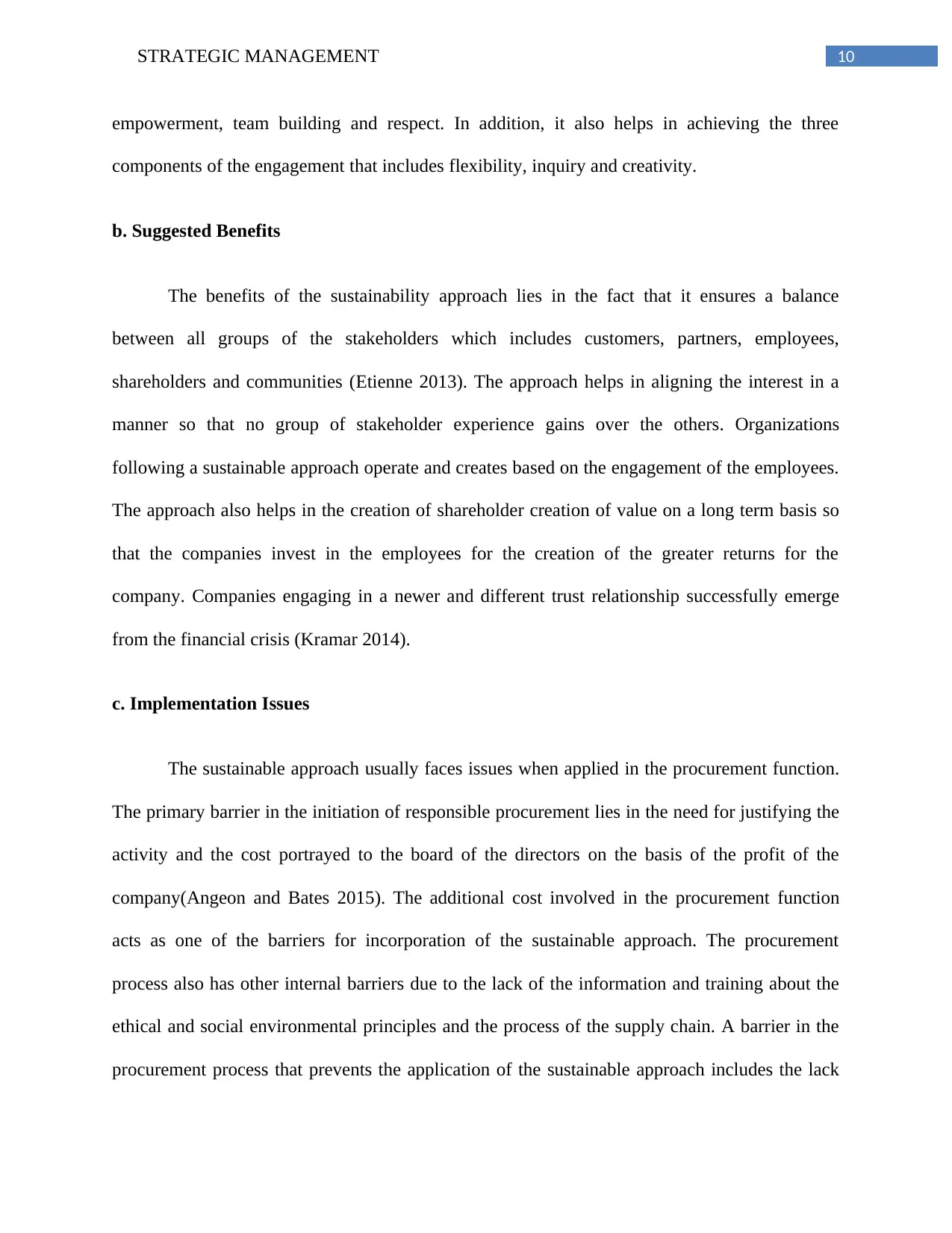
10STRATEGIC MANAGEMENT
empowerment, team building and respect. In addition, it also helps in achieving the three
components of the engagement that includes flexibility, inquiry and creativity.
b. Suggested Benefits
The benefits of the sustainability approach lies in the fact that it ensures a balance
between all groups of the stakeholders which includes customers, partners, employees,
shareholders and communities (Etienne 2013). The approach helps in aligning the interest in a
manner so that no group of stakeholder experience gains over the others. Organizations
following a sustainable approach operate and creates based on the engagement of the employees.
The approach also helps in the creation of shareholder creation of value on a long term basis so
that the companies invest in the employees for the creation of the greater returns for the
company. Companies engaging in a newer and different trust relationship successfully emerge
from the financial crisis (Kramar 2014).
c. Implementation Issues
The sustainable approach usually faces issues when applied in the procurement function.
The primary barrier in the initiation of responsible procurement lies in the need for justifying the
activity and the cost portrayed to the board of the directors on the basis of the profit of the
company(Angeon and Bates 2015). The additional cost involved in the procurement function
acts as one of the barriers for incorporation of the sustainable approach. The procurement
process also has other internal barriers due to the lack of the information and training about the
ethical and social environmental principles and the process of the supply chain. A barrier in the
procurement process that prevents the application of the sustainable approach includes the lack
empowerment, team building and respect. In addition, it also helps in achieving the three
components of the engagement that includes flexibility, inquiry and creativity.
b. Suggested Benefits
The benefits of the sustainability approach lies in the fact that it ensures a balance
between all groups of the stakeholders which includes customers, partners, employees,
shareholders and communities (Etienne 2013). The approach helps in aligning the interest in a
manner so that no group of stakeholder experience gains over the others. Organizations
following a sustainable approach operate and creates based on the engagement of the employees.
The approach also helps in the creation of shareholder creation of value on a long term basis so
that the companies invest in the employees for the creation of the greater returns for the
company. Companies engaging in a newer and different trust relationship successfully emerge
from the financial crisis (Kramar 2014).
c. Implementation Issues
The sustainable approach usually faces issues when applied in the procurement function.
The primary barrier in the initiation of responsible procurement lies in the need for justifying the
activity and the cost portrayed to the board of the directors on the basis of the profit of the
company(Angeon and Bates 2015). The additional cost involved in the procurement function
acts as one of the barriers for incorporation of the sustainable approach. The procurement
process also has other internal barriers due to the lack of the information and training about the
ethical and social environmental principles and the process of the supply chain. A barrier in the
procurement process that prevents the application of the sustainable approach includes the lack
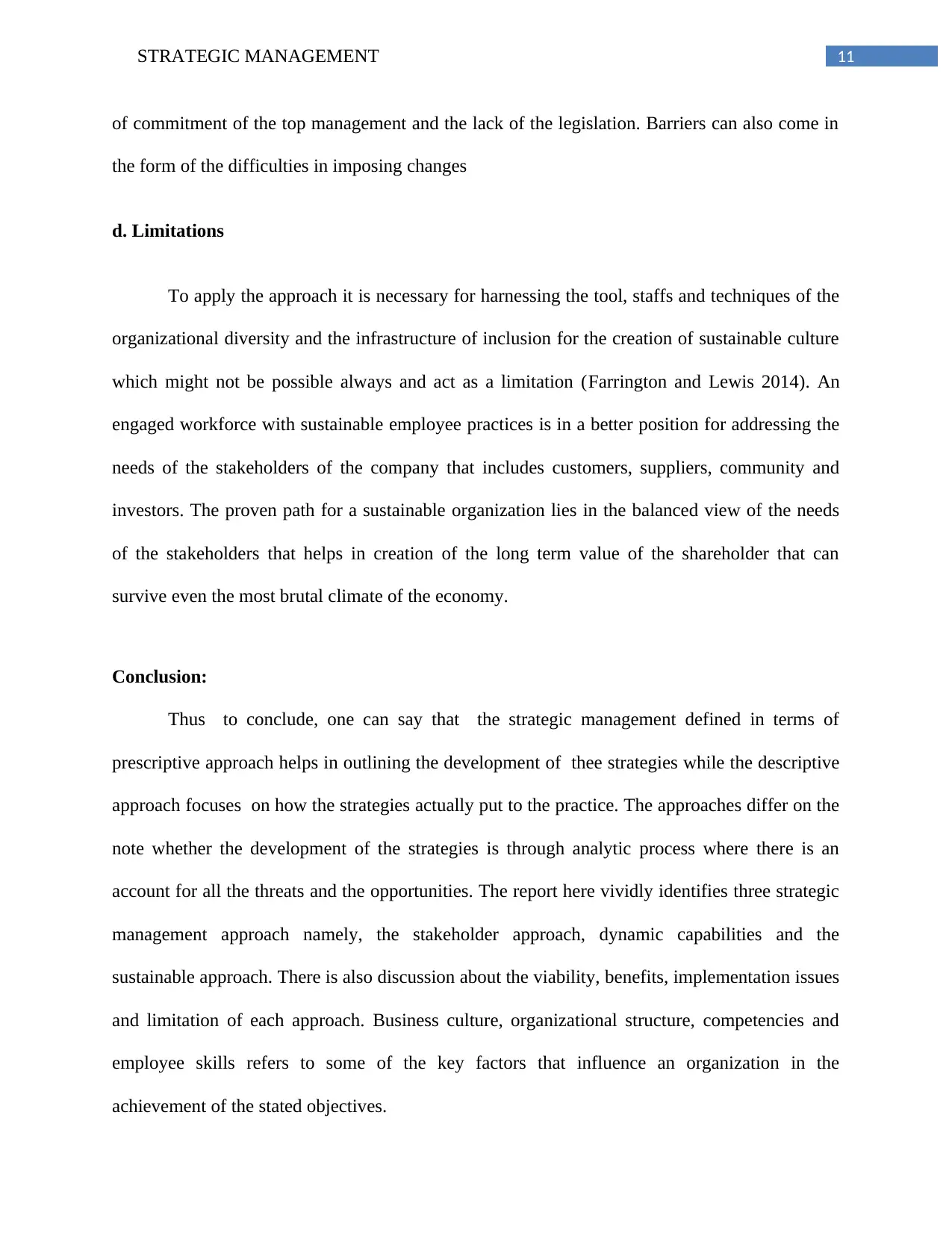
11STRATEGIC MANAGEMENT
of commitment of the top management and the lack of the legislation. Barriers can also come in
the form of the difficulties in imposing changes
d. Limitations
To apply the approach it is necessary for harnessing the tool, staffs and techniques of the
organizational diversity and the infrastructure of inclusion for the creation of sustainable culture
which might not be possible always and act as a limitation (Farrington and Lewis 2014). An
engaged workforce with sustainable employee practices is in a better position for addressing the
needs of the stakeholders of the company that includes customers, suppliers, community and
investors. The proven path for a sustainable organization lies in the balanced view of the needs
of the stakeholders that helps in creation of the long term value of the shareholder that can
survive even the most brutal climate of the economy.
Conclusion:
Thus to conclude, one can say that the strategic management defined in terms of
prescriptive approach helps in outlining the development of thee strategies while the descriptive
approach focuses on how the strategies actually put to the practice. The approaches differ on the
note whether the development of the strategies is through analytic process where there is an
account for all the threats and the opportunities. The report here vividly identifies three strategic
management approach namely, the stakeholder approach, dynamic capabilities and the
sustainable approach. There is also discussion about the viability, benefits, implementation issues
and limitation of each approach. Business culture, organizational structure, competencies and
employee skills refers to some of the key factors that influence an organization in the
achievement of the stated objectives.
of commitment of the top management and the lack of the legislation. Barriers can also come in
the form of the difficulties in imposing changes
d. Limitations
To apply the approach it is necessary for harnessing the tool, staffs and techniques of the
organizational diversity and the infrastructure of inclusion for the creation of sustainable culture
which might not be possible always and act as a limitation (Farrington and Lewis 2014). An
engaged workforce with sustainable employee practices is in a better position for addressing the
needs of the stakeholders of the company that includes customers, suppliers, community and
investors. The proven path for a sustainable organization lies in the balanced view of the needs
of the stakeholders that helps in creation of the long term value of the shareholder that can
survive even the most brutal climate of the economy.
Conclusion:
Thus to conclude, one can say that the strategic management defined in terms of
prescriptive approach helps in outlining the development of thee strategies while the descriptive
approach focuses on how the strategies actually put to the practice. The approaches differ on the
note whether the development of the strategies is through analytic process where there is an
account for all the threats and the opportunities. The report here vividly identifies three strategic
management approach namely, the stakeholder approach, dynamic capabilities and the
sustainable approach. There is also discussion about the viability, benefits, implementation issues
and limitation of each approach. Business culture, organizational structure, competencies and
employee skills refers to some of the key factors that influence an organization in the
achievement of the stated objectives.
⊘ This is a preview!⊘
Do you want full access?
Subscribe today to unlock all pages.

Trusted by 1+ million students worldwide
1 out of 15
Related Documents
Your All-in-One AI-Powered Toolkit for Academic Success.
+13062052269
info@desklib.com
Available 24*7 on WhatsApp / Email
![[object Object]](/_next/static/media/star-bottom.7253800d.svg)
Unlock your academic potential
Copyright © 2020–2025 A2Z Services. All Rights Reserved. Developed and managed by ZUCOL.




